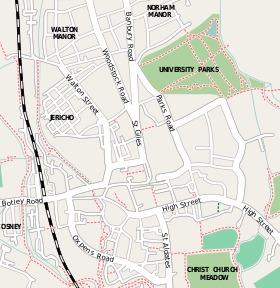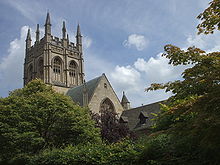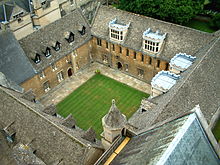- Merton College, Oxford
-
Colleges and halls of the University of Oxford
Merton College
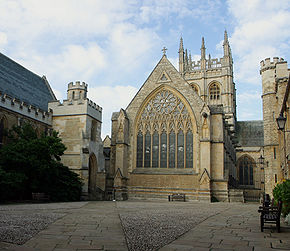
College name The House or College of Scholars of Merton in the University of Oxford Motto "Qui Timet Deum Faciet Bona" Named after Walter de Merton Established 1264 Sister college Peterhouse, Cambridge Warden Prof. Sir Martin Taylor Undergraduates 302 Graduates 298
Location of Merton College within central OxfordCoordinates: 51°45′04″N 1°15′08″W / 51.751062°N 1.252109°WHomepage Boat Club 
Merton College is one of the constituent colleges of the University of Oxford in England. Its foundation can be traced back to the 1260s when Walter de Merton, chancellor to Henry III and later to Edward I, first drew up statutes for an independent academic community and established endowments to support it. The important feature of Walter's foundation was that this "college" was to be self-governing and that the endowments were directly vested in the Warden and Fellows.[1]
By 1274 when Walter retired from royal service and made his final revisions to the college statutes, the community was consolidated at its present site in the south east corner of the city of Oxford, and a rapid programme of building commenced. The hall and the chapel and the rest of the front quad were complete before the end of the 13th century, but apart from the chapel they have all been much altered since. To most visitors, the college and its buildings are synonymous, but the history of the college can be more deeply understood if one distinguishes the history of the academic community from that of the site and buildings that they have occupied for nearly 750 years.[2] Merton is among the wealthier colleges, and as of 2006, had an estimated financial endowment of £142 million.[3]
Contents
History
Foundation and origins
Merton College was founded in 1264 by Walter de Merton, Lord Chancellor and Bishop of Rochester. It has a claim to be the oldest college in Oxford, although this claim is disputed between Merton College, Balliol College and University College. The substance of Merton's claim to the title of oldest College is that Merton was the first college to be provided with "statutes", a constitution governing the College set out at its founding. Merton's statutes date back to 1264, whereas neither Balliol nor University College had statutes until the 1280s. Merton was also the first to be conceived as a community of scholars working to achieve academic ends, rather than just a place for the scholars to live in.
St Alban Hall
St Alban Hall was an independent academic hall owned by the convent of Littlemore until it was purchased by Merton College in 1548 following the dissolution of the convent. It continued as a separate institution until it was finally annexed by the college in 1881.[4]
Parliamentarian sympathies in the Civil War
During the English Civil War, Merton was the only Oxford College to side with Parliament. The reason for this was Merton's annoyance with the interference of their Visitor (patron) William Laud, the Archbishop of Canterbury. Due to this, the college was moved to London at the start of the Civil War and its buildings were commandeered by the Royalists and used to house many of Charles the First's court when Oxford was used as the Royalists' capital. This included the King's French wife, Queen Henrietta Maria, who was housed in or near what is now the Queen's Room, the room above the arch between Front and Fellows' Quads.
Differences were quickly settled after the war, however, and a portrait of Charles the First hangs near the Queen's Room as a reminder of the role it played in his court.
Modern academic community
Merton college admitted its first female students in 1980 (largely due to pressure from the JCR). However men still dominate at Merton and it consistently has one of the highest male to female ratios of an Oxford college (around 3:2).[citation needed] However Merton was the second originally male college to elect a female Warden (in 1994). Merton has traditionally had single sex accommodation for freshers, with female students going into the Rose Lane buildings and most male students going into 3 houses on Merton Street. However, this was changed in 2007, with all fresher accommodation being mixed by gender and course. Merton has had a reputation for having the best food in Oxford since an old Mertonian left money specifically for the improvement of the kitchens,[citation needed] and this budget was further augmented during the two years when Crown Prince Naruhito of Japan studied there (1983–85).
Since the introduction of an official Norrington Table published by the University itself in 2004, Merton has been top five years. It is, thus, the most academically successful College in the last twenty years, with more First Class degrees being awarded to its students than Upper Seconds.[citation needed]
In 2010, it was reported that Merton had not admitted a black student in the previous five years. A university spokeswoman commented that black students were more likely to apply for oversubscribed subjects.[5] The University also reported that Merton had admitted at least one black undergraduate since 2005.[6]
Extracurricular activities
Merton has a long-standing sporting relationship with Mansfield College, with the colleges fielding amalgamated sports teams for nearly all major sports except rowing. The JCR Football Premier Division was (jointly) won for the first time by a Merton team in 2010/11[7]. The side, captained by a Mertonian undergraduate, also reached the semi-finals of Cuppers only to lose out to the Blues-dominated eventual champions Worcester.[8]
Merton[9] has been Head of the River in Summer Eights once; its men's 1st VIII held the headship in 1951. Merton's women have done better in recent years, gaining the headship in Torpids in 2003 and rowing over to defend the title in 2004.
At the (in)famous Time Ceremony, students, dressed in formal sub-fusc, walk backwards around the Fellows' Quad drinking port. Traditionally participants also hold candles but in recent years this practice has been dropped, and many students have now adopted the habit of linking arms and twirling around at each corner of the quad. The purpose is ostensibly to maintain the integrity of the space-time continuum during the transition from British Summer Time to Greenwich Mean Time which occurs in the early hours of the last Sunday in October. There are two toasts associated with the ceremony, the first is "to good old times!", or "to a good old time!", whilst the second is "long live the counter-revolution!". The ceremony was invented by two undergraduates in 1971, partly as a spoof on other Oxford ceremonies, and partly to celebrate the end of the experimental period of British Standard Time from 1968 to 1971 when the UK stayed one hour ahead of GMT all year round. It is also seen by many as a protest against the abandonment of sub fusc in recent years.
In 2003, Merton JCR passed a motion expressing general support for student tuition fees, making it the only pro-tuition-fee student body in the UK.[citation needed]
Merton is the only college in Oxford to hold a triannual winter ball, instead of the more common Commemoration ball.
Merton also plays host to a number of drinking and dining societies, along the lines of other colleges. These include the Myrmidons and L'Ancien Régime. Merton College is also rumoured to be the college of the founding members of the alleged Haxley Society, a university-wide establishment and reportedly a chapter of Yale's similarly prestigious Gamma Gamma Phi fraternity.
Buildings
The "House of Scholars of Merton" originally had properties in Surrey (in present day Old Malden) as well as in Oxford, but it was not until the mid-1260s that Walter de Merton acquired the core of the present site in Oxford, along the south side of what was then St John's Street (now Merton Street). The college was consolidated on this site by 1274, when Walter made his final revisions to the college statutes.
The initial acquisition included the parish church of St John (which was superseded by the chapel) and three houses to the east of the church which now form the north range of Front Quad. Walter also obtained permission from the king to extend from these properties south to the old city wall to form an approximately square site. The college continued to acquire other properties as they became available on both sides of Merton Street. At one time the college owned all the land from the site of what is now Christ Church to the south eastern corner of the city. The land to the east eventually became the present day garden, while the western end was leased by Warden Rawlins in 1515 for the foundation of Corpus Christi (at an annual rent of just over £4).[10]
Chapel
Main article: Merton College ChapelBy the late 1280s the old church of St John the Baptist had fallen into "a ruinous condition",[11] and the college accounts show that work on a new church began in about 1290. The present choir with its enormous east window was complete by 1294. The window is an important example (because it is so well dated) of how the strict geometrical conventions of the Early English Period of architecture were beginning to be relaxed at the end of the 13th century.[12] The south transept was built in the 14th century, the north transept in the early years of the 15th. The great tower was complete by 1450. The chapel replaced the parish church of St. John and continued to serve as the parish church as well as the chapel until 1891. It is for this reason that it is generally referred to as Merton Church in older documents, and that there is a north door into the street as well as doors into the college. This dual role also probably explains the enormous scale of the chapel, which in its original design was to have a nave and two aisles extending to the west.[13]
A new choral foundation was established in 2007, providing for a choir of sixteen undergraduate and graduate choral scholars singing from October 2008. The choir is directed by Peter Phillips, currently also director of the Tallis Scholars and Benjamin Nicholas, director of music at Tewkesbury Abbey
A spire from the chapel has resided in Pavilion Garden VI of the University of Virginia since 1928, when "it was given to the University to honor Jefferson's educational ideals."[14]
Front quad and the hall
The hall is the oldest surviving college building, but apart from the door with its magnificent medieval ironwork almost no trace of the ancient structure has survived the successive reconstruction efforts, first by James Wyatt in the 1790s and then again by Gilbert Scott in 1874. The hall is still used daily for meals and houses a number of important portraits. It is not usually open to visitors.
Front quad itself is probably the earliest collegiate quadrangle, but its informal, almost haphazard, pattern cannot be said to have influenced designers elsewhere. A reminder of its original domestic nature can be seen in the north east corner where one of the flagstones is marked "Well". The quad is formed of what would have been the back gardens of the three original houses that Walter acquired in the 1260s.
Mob quad
Main articles: Mob Quad and Merton College LibraryVisitors to Merton are often told Mob Quad, built in the 14th century, is the oldest quadrangle of any Oxford or Cambridge college and set the pattern for future collegiate architecture, but Front Quad was certainly enclosed earlier (albeit with a less unified design) and other colleges, for example Corpus Christi College, Cambridge, can point to their own older examples.
The old library occupies the upper floor of the south and west ranges of Mob Quad, and the original archive room is still in the north east corner; it houses one of the most complete sets of college records in Europe.
Fellows' quad
The grandest quadrangle in Merton is the Fellows' Quadrangle, immediately south of the hall. The quad was the culmination of the work undertaken by Sir Henry Savile at the beginning of the 17th century. The foundation stone was laid shortly after breakfast on 13 September 1608 (as recorded in the college Register), and work was complete by September 1610 (although the battlements were added later).[15] The southern gateway is surmounted by a tower of the four Orders, probably inspired by Italian examples that Warden Savile would have seen on his European travels. The main contractors were from Yorkshire (as was Savile), John Ackroyd and John Bentley of Halifax did the stonework and Thomas Holt the timber. This group were also later employed to work on the Bodleian Library and Wadham College.[16]
Other buildings
Most of the other buildings are Victorian or later and include: St. Alban Quad (or "Stubbins"), designed by Basil Champneys,[17] built on the site of the medieval St. Alban Hall (elements of the older façade are incorporated into the part that faces onto Merton Street); the Grove building, built in 1864 by William Butterfield but "chastened" in the 1930s;[18] the buildings beyond the Fellows' Garden called "Rose Lane"; several buildings north of Merton Street, including a real tennis court, and the Old Warden's Lodgings (designed by Champneys in 1903);[17] and a new quadrangle in Holywell Street, some distance away from the college.
Gardens
The garden fills the southeastern corner of the old walled city of Oxford. The walls may be seen from Christ Church Meadows. Among other things, the gardens contain a mulberry tree planted in the early 17th century, an armillary sundial, a beautiful lawn, and the old Fellows' summer house (now a music room).
T.S. Elliot Lecture Theatre
A new lecture theatre named after T.S. Elliot, a former member of the college has a bust of the writer by Jacob Epstein, presented by Frank Brenchley, a former member and fellow of the college, who presented his collection of Elliot first editions and ephemera to the college, which is believed to be the second largest collection of such material, worldwide. The foyer is illuminated by a lighting display representing three constellations.
Former Mertonians
Main articles: List of alumni of Merton College, Oxford and List of Wardens of Merton College, OxfordMerton alumni include four Nobel prize winners: poet T. S. Eliot[19], physicist Sir Anthony Leggett, zoologist Nikolaas Tinbergen and chemist Frederick Soddy.[20] Other Merton alumni are Bodleian Library founder Thomas Bodley[19], the Oxford Calculators, Director-General of the BBC Mark Thompson[21] and Sir Andrew Wiles[19] who proved Fermat's Last Theorem. Wilder Penfield, a famous Canadian neurosurgeon had also previously entered Merton College.
Author J. R. R. Tolkien was a Merton Professor of English Language and Literature [22]
Grace
The college preprandial grace is always recited before formal dinners in Hall and usually by the senior postmaster present. The first two lines of the Latin text are based on verses 15 and 16 of Psalm 145.
- Oculi omnium in te respiciunt, Domine. Tu das escam illis tempore opportuno.
- Aperis manum tuam, et imples omne animal benedictione tua.
- Benedicas nobis, Deus, omnibus donis quae de tua beneficentia accepturi simus.
- Per Iesum Christum dominum nostrum, Amen.
Roughly translated it means:
- The eyes of the world look up to thee, O Lord. Thou givest them food in due season.
- Thou openest thy hand and fillest every creature with thy blessing.
- Bless us, O God, with all the gifts which by thy good works we are about to receive.
- Through Jesus Christ, Our Lord, Amen.
For the relevant verses of the Psalm, the Authorized Version has:
- 15. The eyes of all wait upon thee; and thou givest them their meat in due season.
- 16. Thou openst thine hand, and satisfiest the desire of every living thing.
According to an article about Graces from the University of Cambridge, a slightly different version of the Latin text of these verses is painted (apparently as a decoration) around Old Hall in Queens' College, Cambridge, and is "commonly in use at other Cambridge colleges".
By contrast with the rather long pre-prandial grace, the post-prandial grace is brief: Benedictus benedicat ("Let him who has been blessed, give blessing"). The latter grace is spoken by the senior Fellow present at the end of dinner on High Table.
Gallery
-
Merton College (including chapel) viewed from the north from St Mary's Church
References
- Bott, A. (1993). Merton College: A Short History of the Buildings. Oxford: Merton College. ISBN 0-9522314-0-9.
- Martin, G.H. & Highfield, J.R.L. (1997). A History of Merton College. Oxford: Oxford University Press. ISBN 0-19-920183-8.
- Sherwood, Jennifer; and Nikolaus Pevsner (1974). The Buildings of England: Oxfordshire. Harmondsworth: Penguin Books. ISBN 0-14-071045-0.
- ^ See Martin & Highfield, pp.1–2
- ^ See Martin & Highfield, loc. cit.
- ^ Oxford College Endowment Incomes, 1973-2006 (updated July 2007)
- ^ "St Alban Hall, Library & Archives, Merton College website". http://www.merton.ox.ac.uk/aboutmerton/library4.shtml. Retrieved 20 July 2009.
- ^ Davis, Anna (7 December 2010). "Oxford college fails to take black students". London Evening Standard. http://www.thisislondon.co.uk/standard/article-23904554-oxford-college-fails-to-take-black-students.do. Retrieved 8 December 2010.
- ^ Mapstone, Sally (9 December 2010). "These figures do not show that Oxford and Cambridge discriminate". Guardian. http://www.guardian.co.uk/commentisfree/2010/dec/09/oxford-cambridge-do-not-discriminate. Retrieved 10 December 2010.
- ^ http://merton-mansfield.ouafc.com/college_tables?division_id=1
- ^ Bush, Stephen (3 March 2011). "Worcester 5-1 Mertsfield". Oxford Student. http://oxfordstudent.com/2011/03/03/worcester-5-1-mertsfield/. Retrieved 3 March 2011.
- ^ http://www.mertoncollegeboatclub.com
- ^ See Bott, p.4
- ^ Anthony Wood, quoted in Bott, p.24
- ^ Pevsner, p.25
- ^ See Bott, pp.24–37
- ^ "University of Virginia: Explore the Gardens, Pavillion Garden VI". http://www.virginia.edu/virginia/.+2009-06-11. http://www.virginia.edu/uvatours/gardens/gardensExplore.html. Retrieved 2009-06-11.
- ^ Bott, p.37
- ^ Martin & Highfield, p.163
- ^ a b Brock, M.G. and Curthoys, M.C., The History of the University of Oxford, Volume VII, Part 2 — Oxford University Press (2000) p.755. ISBN 0-19-951017-2.
- ^ Pevsner, op. cit., p.164
- ^ a b c "Episode 8". University Challenge. BBC. Two. 2011-08-22. No. 8, series 2011/12.
- ^ www.merton.ox.ac.uk/aboutmerton/people_eminent.shtm
- ^ “THOMPSON, Mark John Thompson,” in Who's Who 2009 (London: A & C Black, 2008); online ed., (Oxford: OUP, 2008), [1] (accessed January 25, 2009).
- ^ Daniel Grotta (28 March 2001). J.R.R. Tolkien Architect of Middle Earth. Running Press. pp. 64–. ISBN 9780762409563. http://books.google.com/books?id=9LHQvq6P5qIC&pg=PA64. Retrieved 22 August 2010.
External links
University of Oxford Leadership Chancellor: The Lord Patten of Barnes · Vice-Chancellor: Dr Andrew Hamilton · Registrar: Ewan McKendrick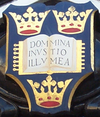
Colleges All Souls · Balliol · Brasenose · Christ Church · Corpus Christi · Exeter · Green Templeton · Harris Manchester · Hertford · Jesus · Keble · Kellogg · Lady Margaret Hall · Linacre · Lincoln · Magdalen · Mansfield · Merton · New · Nuffield · Oriel · Pembroke · Queen's · St Anne's · St Antony's · St Catherine's · St Cross · St Edmund Hall · St Hilda's · St Hugh's · St John's · St Peter's · Somerville · Trinity · University · Wadham · Wolfson · WorcesterPermanent Private Halls Recognised Independent Centres Sport Categories University · Chancellors · Colleges · Permanent Private Halls · Departments · Academics · Chairs · AlumniCategories:- Merton College, Oxford
- 1264 establishments in England
- Educational institutions established in the 13th century
- Colleges of the University of Oxford
- Buildings and structures of the University of Oxford
- Grade I listed buildings in Oxford
- Grade I listed educational buildings
Wikimedia Foundation. 2010.

